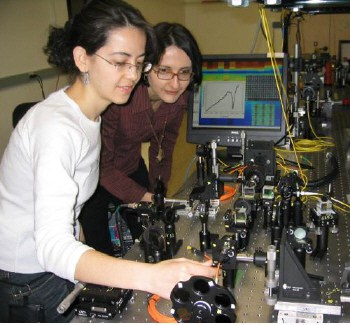Researchers in the US have succeeded in reducing the group velocity of light by a factor of more than 100 in a novel two-dimensional photonic crystal. Halice Altug and Jelena Vuckovic of Stanford University say the device could be used for a variety of optical applications and components, including high-power photonic crystal lasers with low thresholds (Appl. Phys. Lett. 86 111102).

Photonic crystals are nanostructured materials in which a periodic variation of the dielectric constant of the material results in a photonic band gap. Photons with wavelengths or energies in this gap cannot travel through the crystal. By introducing defects into photonic crystals it is possible to build waveguides that can channel light along certain paths. It is also possible to construct microcavities that can localise photons in extremely small volumes. Altug and Vuckovic have now demonstrated that photonic crystal arrays can also be used to produce “slow light”.
Two types of velocity are used to describe the propagation of a wave in a dispersive medium: the phase velocity and the group velocity. The phase velocity is the speed at which light of a single wavelength moves. However, a pulse of light contains a range of wavelengths that all move at different speeds, so the group velocity is defined as the speed at which the pulse itself moves. Low group velocities are beneficial for many device applications because they enhance the interactions between the light and the material in the device.
Altug and Vuckovic made an array of 3600 microcavities in a slab of silicon that had an area of 100 square microns. The holes in the array were 400 nanometres across and the period of the crystal was 500 nanometres. The Stanford pair found that the group velocity of a laser pulse was reduced by more than a factor of 100 when it travelled through the array.
The duo is now testing lasers made from their array in an indium-phosphide material. “As a result of the phase-coupled operation of a large number of microcavities and increased interaction between light and the active medium, we can obtain output powers that are comparable to standard semiconductor lasers, but with significantly lowered threshold pump powers and with increased modulation speed,” Vuckovic told PhysicsWeb. “This is important for building optical interconnects for future computers operating at speeds above 20 gigahertz where presently used electrical interconnects have severe limitations.”




